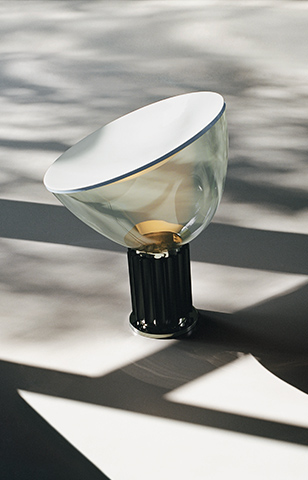Interview by Fabio Cherstich
Photography by Robert Rieger
Formafantasma’s SuperWire is born from the designers’ experimentation with the illuminating filament of LED bulbs, which they manipulated in its flexibility and aesthetic presence to create a collection of modular lamps that merge an industrial attitude with timeless design codes.
Captured by Robert Rieger at Giuseppe De Finetti’s Villa Crespi, the collection comprises a table, suspension and floor version. Each lamp is characterised by a hexagon footprint and made of planar glass panels connected with aluminium elements, illuminated by a thin, flat, soft and flexible LED strip, a unique innovation especially developed by Flos to measure up to one metre in length.
Theatre and Opera Director Fabio Cherstich met Formafantasma’s Andrea Trimarchi and Simone Farresin, for a conversation that mapped the studio’s work through a cultural lens that explored their practice from the inside out.
"The relationship humans have with light transcends a functional dimension and is elevated to an emotional one."
- Andrea Trimarchi
The floor version of SuperWire reminds me of a rocket. I want to give our conversation the arc that Georges Perec traces in his book "Species of Spaces", exploring spaces from the blank page, to the bed, to the desk, to the house, to the city, to the State, up to the earth seen from the constellations. I imagine myself riding your missile-lamp, projected towards the ocean of your work, like Astolfo flying towards the moon...
A.T.: SuperWire is definitely a bit of a rocket so it seems like a fitting image to me!
S.F.: It is very difficult to draw the boundaries of our practice. We always talk about the limits of the design discipline because we want to be rooted within them, but we are interested in pushing the limits of that discipline, even if not in a programmatic way. We do it by following the attitude we have built in this time. In our case the page exists only on a metaphorical level, because ours is a two-way dialogue, we are never faced with the dilemma of the blank page. If there is a dialogue there is always a beginning.
A.T.: All the themes we cover with our work come from our interests. To return to the discussion of borders, ‘design’ can mean many things, and this places us in a limbo. We come from the world of product design, but the interests, problems and urgencies of twenty years ago are completely different from those of today: design has always been a promoter of contemporaneity. And if in the post-war period the idea was to create objects that could be useful, we think that today utility is probably not the only one.
And in the case of SuperWire, what was the exchange of dialogue that the lamp originated from, and how did Flos accommodate this technological madness of yours with an art-deco flavour, which then translated into such a complex lamp?
SF: When we saw this 30 centimetre long flexible filament, we immediately said that we wanted to use it for a project, so we started from the technology.
AT: Usually these filaments were five, six centimetres long, then we found the 30 centimetre one, but the technology was not developed enough to be able to arrive at a very long filament, which was then developed with Flos R&D.
SF: The lamp reflects on topics that we had already explored many years before with a project called Ore Streams, on the electronics industry and the lack of repairability. Since this topic is very important both for us and Flos, SuperWire has been designed to be completely disassembled, including the LED light source, customized by Flos R&D to be autonomously replaced by the user.
Your projects are born from words and constant dialogue between you and the team. This is truly unexpected for me... a studio work made of flows of words and dialogues rather than graphic signs...
SF: Yes, and editing. Over time this name that we chose at the beginning of our journey, Formafantasma, is becoming more and more rooted in our process, and we are using its possibilities, but also its limits. We chase ideas and this means that sometimes we end up in territories that are not ours.
AT: We can enter into discussions with anyone, our projects speak to anthropologists or scientists. What changes is the way we operate, the position we take within a project. There were very few times in which we went beyond our role as designers, and those times we understood that we had to stay within our limits.
What does the Earth look like from the outside, from Formafantasma galloping on their SuperWire?
SF: We have a perception of the Earth as a complete and finite planet. As designers, we are aware of the global complexity of infrastructure, design and production, and this awareness gives us a strong sense of responsibility. The world is not only the planet we live on, but also how we transform and reassemble it. There is no single image of the planet; living as humans on Earth means constantly creating worlds. We can build these worlds in collaboration with other species or alone, but in solitude we risk creating deserted planets.


























